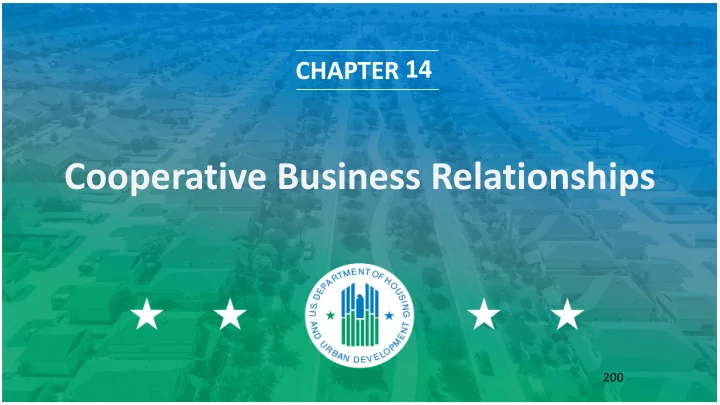

14 CHAPTER Cooperative Business Relationships 200
Contents • Intergovernmental Agreements • Inter-agency Agreements for Joint Procurement Activity • Joint-venture Partners • Consortia 201
Methods for Implementing • Maximize efficiency in terms of both time and money • Collaborate with other public and private entities with respect to procurement • Contract directly with another government • Joining together with another governmental agency to conduct a competitive solicitation • Buying from GSA IT Schedule 70 • Contract directly with a firm that has properly competitively solicited a contract with a firm (i.e., piggybacking) 202
Intergovernmental Agreements: Requirements • Must be between PHA and state or local government agency • Must meet competitive and non-competitive requirements • Procurement process used by original agency must not be in violation of requirements of 2 CFR §200.317–200.326 • Agreement must provide efficiency and result in cost savings • Agreement is for common supplies and routine services • Procurement file must contain a copy of Intergovernmental Agreement and document: • Cost and availability were evaluated prior to the agreement; and • Cost and availability are compared annually 203
Intergovernmental Agreements: Process to Enter • Governmental agency solicits bids and contracts with vendor • PHA enters into agreement with agency so that it can order from that vendor either directly or through the government agency • NOTE: HUD provides an exception to this requirement if state and local laws do not require such—virtually every state doesn’t require this step • PHA can order supplies or services covered by contract at specified prices 204
Intergovernmental Agreements: Terms • Name of parties and affiliation • Effective date • Purpose of the agreement • Procedures for providing list of needed items • Description of items to be purchased • Lead party in the procurement • Policies, rules that must be followed in the procurement • Delivery terms • Type of contract • Warranty 205
Intergovernmental Agreements: Terms (cont.) • Fees to be paid to lead agency (if applicable—usually not) • Procedures for dispute resolution with contractors • Procedures for dispute resolution between parties • Procedures for modification and termination • Provisions for meetings on specification issues • Non-exclusivity clause • Allows PHA to conduct other procurements for similar products • Authorized signatures and titles 206
Inter-entity Agreements for Joint Procurement • When two or more non-federal entities enter into an agreement to conduct a joint solicitation and enter into a single contract with a vendor • Creates efficiency and economies of scale in pricing • Agreements must conform to requirements of intergovernmental agreement 207
Joint-venture Partners • Methods of selecting joint-venture partners: • Qualifications Based Selection (QBS) using an RFQ subject to negotiation of fair and reasonable price • Using a sole-source proposal (under certain conditions) • Procurement requirements of JV partners: • JV partner is not a grantee or subgrantee • JV partner is not bound by 2 CFR §200 in procurement of supplies or services 208
Joint-venture Partners and Identities of Interest • Procurement Requirements of JV Partners and Identity of Interest • A JV partner may contract with an identity of interest without further procurement if: • Identity of interest party was specified in the JV partner RFP or RFQ response • PHA demonstrates that, in selecting JV partner, provision of such goods or services was anticipated • Compensation to identity of interest party is structured to prevent duplication of profit or expenses • PHA demonstrates selection is reasonable based on market cost and availability 209
Consortia • Partnerships between two or more PHAs that submit joint plans to HUD to combine all or part of their funding and program administration • Consortia must comply with 2 CFR §200 210
Recommend
More recommend